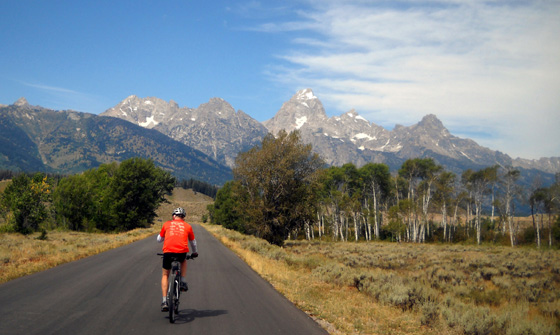This year visitors in Anchorage may be confused about which season it
is. The calendar says "summer" but the chilly temperatures at sea level
and the remaining snow in the surrounding mountains say "late winter" to those of
us from warmer climes.
I'm very happy in Anchorage. Contrary to Chekhov's assertion,
however, I'm very aware of the weather and perceived season.
We've been in Anchorage two weeks now. We extended our stay at the
Black Spruce Campground at Joint Base Elmendorf-Richardson (JBER) twice because
we liked it so much and found plenty of interesting things to do in the
area -- despite some cold, wet weather. We had enough beautiful
sunny, warm days to form mostly positive impressions and memories of the
city and its environs.
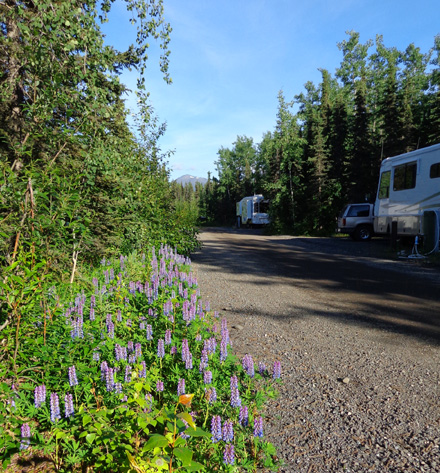
Lupines blooming at Black Spruce CG; our camper is
the one in the distance.
Now it's time to explore another part of the state. We recently made
reservations at the Russian River National Forest Service campground on
the Kenai (KEEN-eye) Peninsula for
the 4th of July holiday. We'll be heading that way in the morning.
One of the fascinating things to me about visiting Alaska is learning new things
about how the people live, their cultural traditions and history,
different ecological environments, and so on.
This entry is a hodgepodge of some of our observations and activities
in Anchorage, tidbits that didn't seem to warrant separate entries but
information I still want to share with readers -- including some of the
new things we've learned.
The photos on this page are ones I've taken in the last two weeks.
They may or may not relate to the topics discussed here (most are wildflowers).
RELAXING AT JBER
When we first arrived at the Black Spruce CG we were "bugged" by
mosquitoes, not so bad that we had to use the head nets we purchased
before coming to Alaska but annoying enough to discourage us from
sitting outside the camper.
Within a couple days the campground was sprayed and it's been great
since then. That was one reason we decided to stay here another week
instead of going down to the Kenai earlier.
There is a lot to do
in the Anchorage area, regardless of your interests. We like the
conveniences, too -- just about any goods or services we could
want. Those are nice to have between our visits to more remote areas of
the state where they will be more expensive or unavailable.
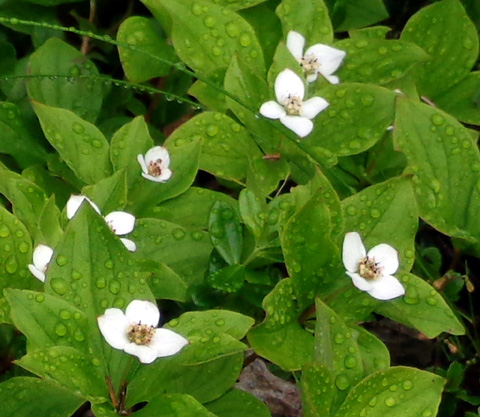
Bunchberry AKA dwarf dogwood blossoms after a rain
shower
After visiting the Kenai Peninsula we'll return to Anchorage for another week or two before
heading farther north to the Mat-Su Valley, Denali National Park, and
Fairbanks.
It's been fun to learn about the flora and fauna in different parts of Alaska. I've already
shown some photos of the moose and bears we've encountered in town. I'm
also impressed with all the beautiful flowers that are in bloom, which
help to dispel the gloom on rainy days.
The lupines haven't quite peaked yet in the campground; I hope
some remain when we get back in a few weeks:
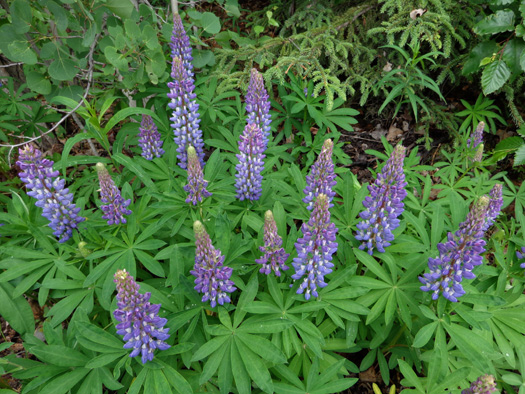
Cotton from cottonwood trees has been flying around the campground and
city while weíve been here. We didnít know they grow this far north.
They are prolific in CO, WY, SD, and other places where we've lived or
visited.
OTTER LAKE
JBER has three campgrounds. Black Spruce is on the Fort Richardson side
of the joint base,
and we like it the best. There is another heavily-treed RV campground near the BX and
commissary on the Elmendorf AFB side and a more remote campground
suitable for tents and smaller RVs at Otter Lake.
This morning we took a ride to Otter Lake, three miles north of our
campground. It is one of three lakes accessed by gravel Otter Lake Road, which
extends about ten miles through the northeast part of JBER (this is a huge
joint base).
Otter Lake has rental cabins, a lodge, and some campsites:
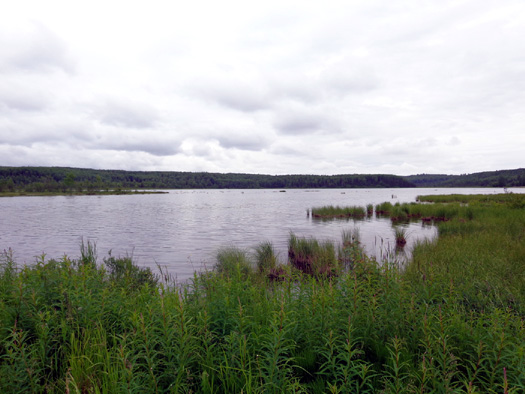
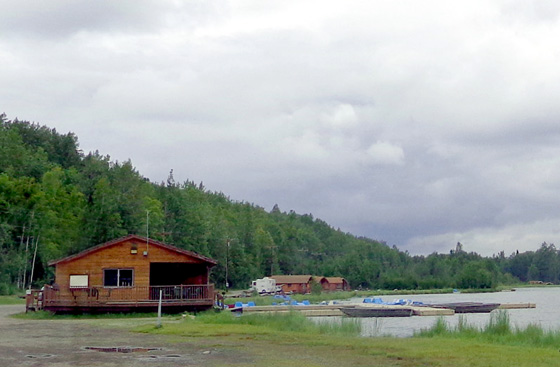
We didnít see any bears or moose, probably because we drove up there too
late in the morning. We talked with some other people in our campground
who went up there yesterday morning and watched a black bear go from one
picnic table to the next, entertaining the campers.
WINE TIME
Black Spruce CG doesn't have free WiFi that reaches back to our site.
About every other day Jim has gone over to the BX or library on base to
use free WiFi to do web searches, upload photos to this website, watch
movies, etc. That helps us save on our Verizon MiFi service, which we
still have to use for secure transactions or whenever I want to get
online with my PC, which isn't portable like Jim's laptop.
One evening
when Jim went to the BX to
get online he did some shopping and brought me back a bottle of Bear Creek
rhubarb-strawberry wine made in Homer, AK. It was about 75 cents less
there than at Walmart.
I told Jim I didnít get it at Walmart because it would
have been the most expensive bottle of wine Iíve ever purchased! I'm pretty sure it's
still the most expensive bottle of wine I've ever enjoyed. It's
tasty.

Above and below: Cow parsnips (kind of like
Queen Anne's lace) along the Coastal Trail
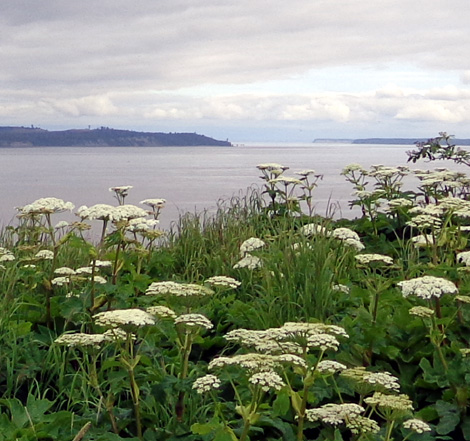
I read about Bear Creek's rhubarb wine in several RVersí Alaska blogs and wanted to try it
while weíre here. Walmart and the BX didnít have the rhubarb wine, which is
more dry than the blend with strawberry. I like the sweet taste of this
wine; it's nice as an after-dinner drink to sip in the evening
while I'm on the computer or reading.
Bear Creek
blends at least a dozen kinds of wine and offers tours. We like wineries
so weíll have to check it out when weíre down in Homer.
F-22 RAPTORS
Another observation about our life at JBER -- the F-22 Raptors
that are used for training here. They are noisy when they fly over the
campground but they're awesome aircraft.
One morning we were driving toward the flight line at Elmendorf on
our way out of the base and stopped to take some pictures of a pair of F-22s
taking off and landing:
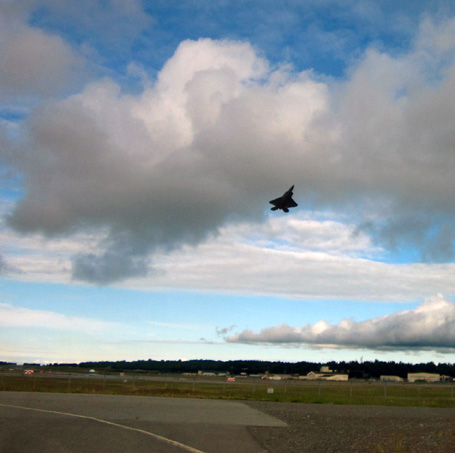
F-22 Raptors are the newest, "baddest" fighter jets in the U.S. fleet and look similar to
F-16s in flight. I got several pictures of them airborne, including the one above.
Elmendorf AFB (the
"E" part of JBER) is one of several Air Force bases in our country with
F-22s. You can read more about their capabilities on Lockheed-Martin's
website.
I don't know
whether to feel more safe or more vulnerable hanging out where these
things are . . . because they make a tempting target for our
country's enemies. Guess you could say that about most any of the
military posts and bases where we like to camp!
BUSH MAIL SERVICE
One of many new things we're learning about Alaska is the difficulty
of living in the Bush. Here's an example of the challenges facing some
of the residents.
The first time we visited the Walmart at Dimond Blvd. and Seward Hwy.
in the south part of Anchorage I noticed a big sign in the back of the
store: BUSH MAIL.
I did a double-take. Bush Mail???
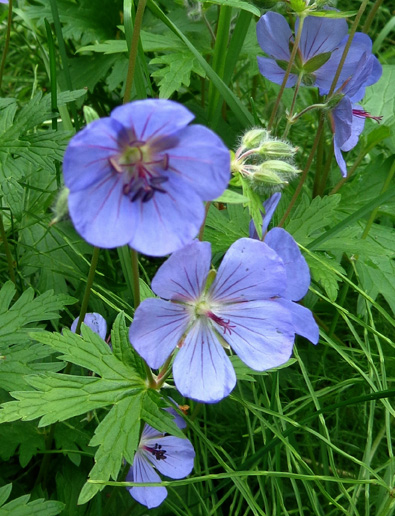
Wild geraniums along the Coastal
Trail
I initially figured it is something like our mailing service in South
Dakota, where our mail is sent when we're traveling. We notify the
company when and where we want to receive our mail and they forward it
to us. Perhaps people in the Bush use this Walmart address as their
mailing address?
After I did some online research I discovered I was wrong about how
Bush Mail works. I also learned more about the challenges of
living in a truly remote corner of the world.
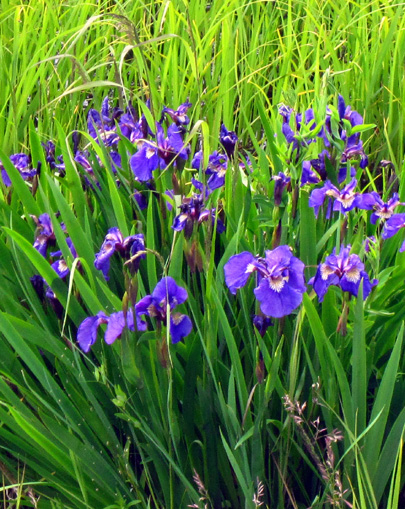
Wild iris at Potter Marsh
First of all, most people living in remote Alaskan villages cannot
catch, make, or purchase locally all of the items they need to survive,
let alone all the other things they want to make their lives
happier.
Second, many items they can get locally are even more
expensive than they are in cities like Fairbanks or Anchorage. Most
things used in Alaska are shipped, flown, or driven there.
Transportation costs make nearly everything cost more in Alaska.
Third, most of these towns and villages are not located on the
limited highway grid. That's why they are considered "Bush"
communities. They are often on rivers or coasts, however, and they usually
have places where airplanes can land (dirt, grass, snow, water). Instead
of receiving supplies by truck or personal vehicle, they get them by
boat or small airplanes.
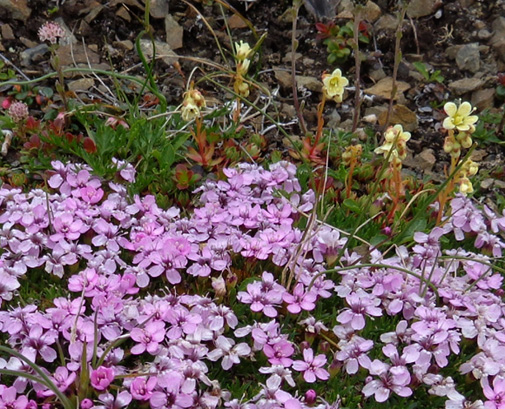
Purple phlox on Rendezvous Ridge
Residents in far-flung areas of Alaska often buy large quantities of
food and other supplies by phone or online and have them
shipped by boat, rail, truck, and/or airplane to their community. They
use the Bush Mail services offered by Walmart, Sam's Club, Costco, and
other businesses in the larger cities in Alaska.
Even
though they're purchasing in quantity at lower prices they still have to
pay handling and shipping costs -- plus their own transportation
costs if they fly or drive to Anchorage or Fairbanks to buy the goods.
Some folks in remote areas with roads also buy in quantity in the cities
to save money. If they shop in person and can't get all the goods in their
vehicle or airplane luggage, they can also use the Bush Mail services to
get the items to their home.
In what other U.S. state will you find Bush Mail Service??
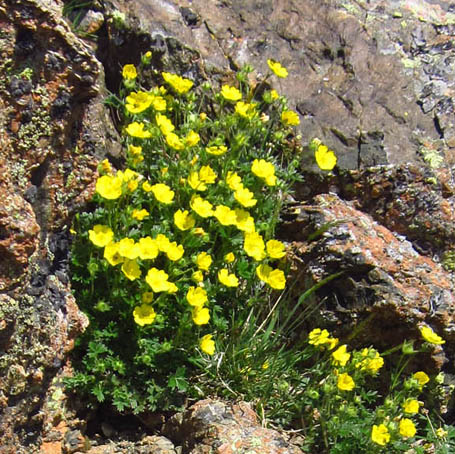
Bright cinquefoil on Flattop
Mountain's summit
While doing a web search I came up with this womanís
website
and found an explanation of how Walmart's Bush Service works to reduce the
cost of parcel post through the Post Office, especially after significant 4th-class
postal cost increases this spring that significantly affect all rural Americans
but especially Alaskans:
The walmart in Anchorage also has a thing
called the bush department. While at walmart you can fill up your cart
with things that you want to buy and then drop it off at the Bush
counter. They will shrink wrap it, box it up and send it C.O.D. to you
in your village. You can also call them up on the phone and tell them
what you want and they will box it up and mail it C.O.D. Of course this
service isn't free. On the total of your merchandise you pay a 15%
handling fee and 26% for postage. Even still it is often cheaper to get
things you want than buying it at the ONE store here in Kotzebue.
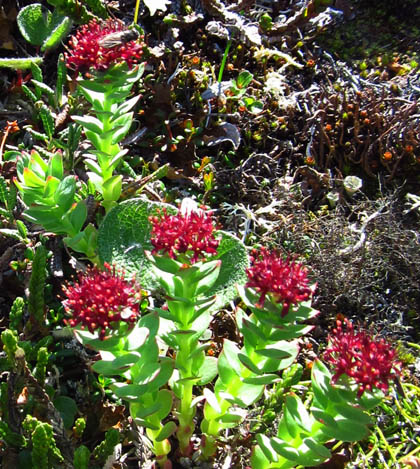
Showy
succulent flower on Rendezvous Ridge
Another observation about
higher prices . . .
Crude oil has recently dropped to $78/barrel from over
$100/barrel in the spring. According to a recent RV Travel e-newsletter
the average price of diesel the week of June 18 was $3.72/gallon. It was
$4.19/gallon on base when we got here about that time, the cheapest
weíve seen in Anchorage. It dropped a few cents last week to
$4.11/gallon but itís as much as $4.29 in town. Itís even higher in
smaller communities and very high in the Bush.
Everything
is more expensive up here because of transportation costs. Iím not sure
that wages and salaries are commensurate with the overall cost of living, which is one
reason for the annual oil dividend that residents receive (the PFD, or
Permanent Fund Dividend).
It's a financial incentive to get people to live
up here. No state income tax or sales tax helps, too.
ALASKA'S SALMON
INDUSTRY
Here are some things weíve learned about another significant economic
challenge for many Alaskans.
Fishing for five
different
species of wild Pacific salmon (and some other fish like halibut) is a huge business in this state. King
AKA Chinook salmon are supposed to be
returning to their spawning grounds in Alaska this time of year but the
count is very low where their numbers are measured downstream.
It remains to be seen if any of the other four kinds of salmon that
spawn in Alaska will have low counts this year. Their numbers vary from
year to year and species to species.

Delicate white flowers on Rendezvous Peak
Last week the Alaska Dept. of Fish and
Game decided to ban and/or strictly limit the number of kings that can
be harvested from some rivers in South Central Alaska, which includes
Anchorage and the Kenai Peninsula. Itís critical to conserve the
remaining fish so they can reproduce.
This is big news in
this area because it affects so many people. Weíve heard about it on the
local newscasts for several days.
I found these articles on the Alaska Dispatch websive that explain the
problem and the resulting conflicts/controversy:
http://www.alaskadispatch.com/article/king-salmon-clamp-down-binds-southcentral-alaska-fishermen
and
http://www.alaskadispatch.com/article/state-officials-try-contain-western-alaska-salmon-revolt.
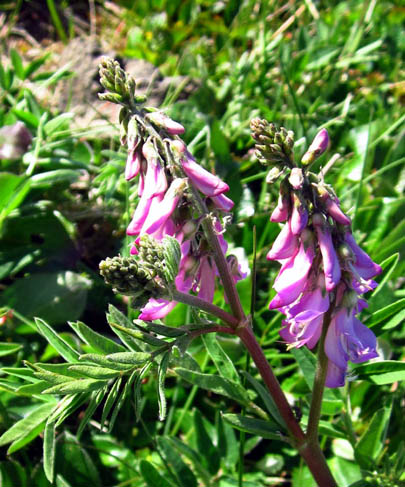
Sweet vetch near Flattop Mountain
The economy is
affected in many ways:
-
Commercial fishermen and the people they hire make their living catching
and selling the salmon. A ban or severe restrictions can lead to higher unemployment and
businesses going bust.
-
If sport fishermen canít fish, they donít visit these communities and
support local businesses like charter companies, RV parks, motels,
grocery stores, gas stations, etc.
-
Consumers will ultimately pay more at the grocery to buy more scarce salmon
products.
-
The group I
sympathize with the most are the indigenous people who rely on the
salmon they catch for their main source of food in the winter. These are
subsistence users who have relied on salmon for centuries. I think they
should have priority over everyone else for the few fish that are
permitted to be caught. The competing groups disagree because they have
their own vested interests.
The bans/restrictions
on sport fishermen may turn out to be a benefit to us this summer if
itís easier to find campsites when weíre traveling through the Kenai
Peninsula in July. Many Anchorage residents go down there on weekends to
fish. If they know the fish aren't available, they'll cancel their
reservations.
In the long run, though, the higher prices may affect us when we buy
salmon here.
TIME TO MOVE ON
I enjoy learning all these new things about what
it's like to live in such a different place than I'm used to. In some
ways it's like being in a foreign country.
On rainy days this past week we spent more time reading over material online, in
our Milepost and Alaskan Camping books, and the
promotional brochures we've gathered about places we
want to go on the Kenai Peninsula.
There is so much information, and so many places to visit and things to do,
that it gets a bit overwhelming to plan even for the next week,
let alone any longer.
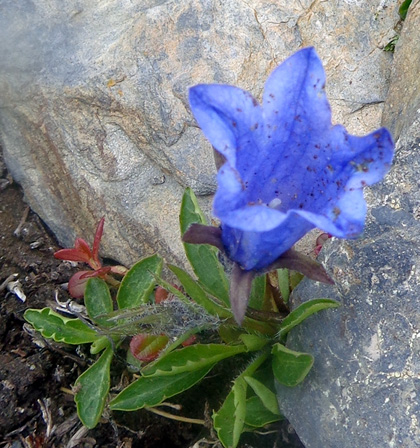
Small blue flower on Rendezvous Ridge, the only one
I saw up there
Weíre glad we have reservations at Russian River
for the 4th of July holiday (but for only three days, the maximum
allowed when the salmon are running). Weíll be camped in the busiest
sockeye AKA red salmon fishing area of the state -- if they are
running in larger numbers than the kings this year.
Even though we donít fish itís
supposed to be fun to watch everyone else fish there.
We considered visiting Seward over the 4th
but discovered that the campgrounds (and other accommodations) are
booked long in advance for the holiday. Many thousands of people descend
on Seward for the festivities there. We weren't able to make
reservations before the 4th but we can camp at the Seward Military
Resort for several days after the holiday.
This is one example of how we're being flexible
on this trip. Since we don't have to be in Seward for any special
event it is fine with us to go at a later time. I know we'll enjoy it
more when it's less crowded.
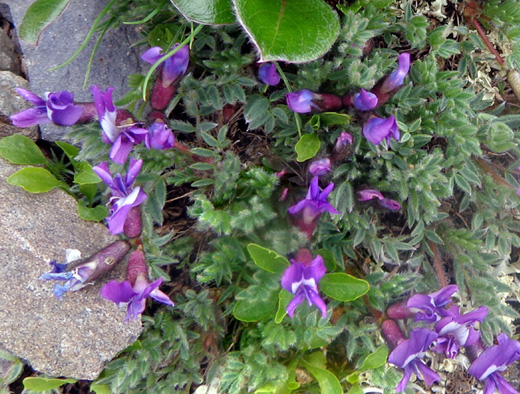
Another kind
of blue flower on Rendezvous Ridge
One day this week when Jim was at the library on base he got a
brainstorm and borrowed two DVDs. Good decision!
The first was a 60-minute movie by Alaska Video Postcards about Kenai
Fjords National Park, located on the SE coast of the Kenai Peninsula.
The second video, produced by the same company, was about Denali
National Park. It focused on the wildlife and seasonal changes in the
park. Most people see it only in the summer, which is a very short
season at that latitude and elevation.
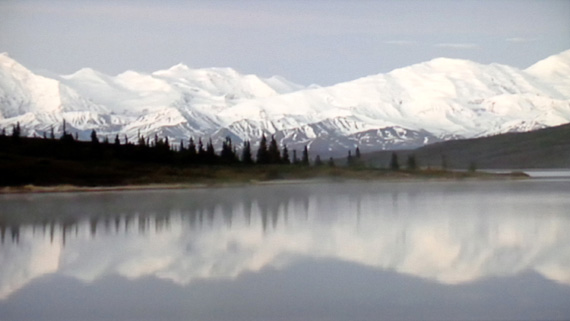
Denali National Park reflections from the video; I
took some photos
while watching the video and this one came out
better than most.
Both videos
were excellent and got us even more psyched up about some of the things
we'll be seeing this summer!
We'll be leaving Anchorage tomorrow morning for an undetermined number of weeks on
the Kenai Peninsula. Other than our reservations at Russian River and in
Seward the next eight or nine days we'll be playing the rest of our visit
in that region by ear.
Next entry: trip notes from Anchorage to the Russian River
Campground
Happy trails,
Sue
"Runtrails & Company" - Sue Norwood, Jim O'Neil,
and Cody the ultra Lab
Previous
Next
© 2012 Sue Norwood and Jim O'Neil
